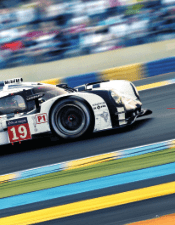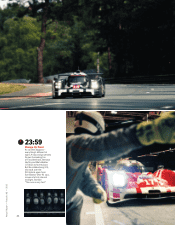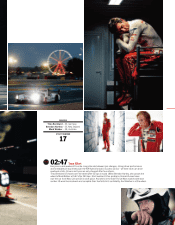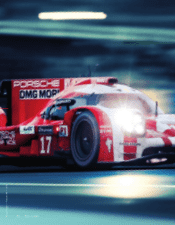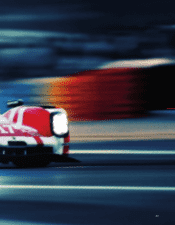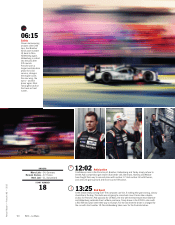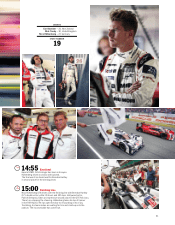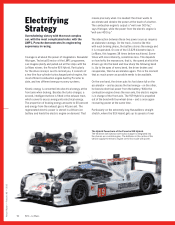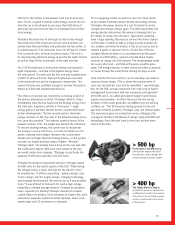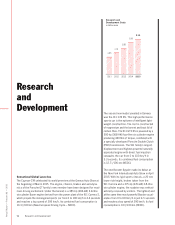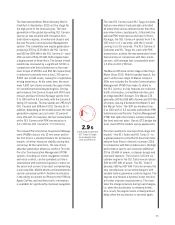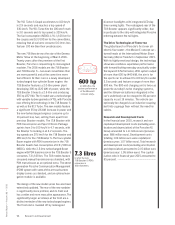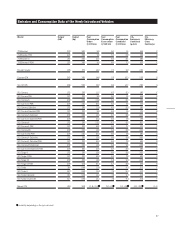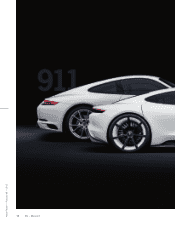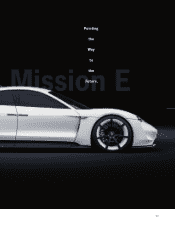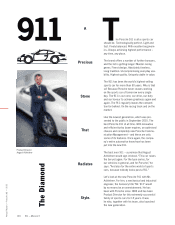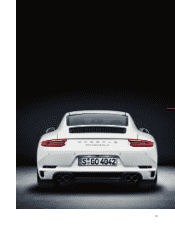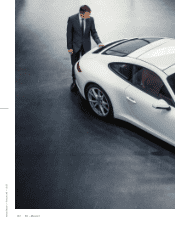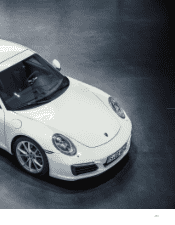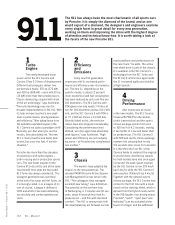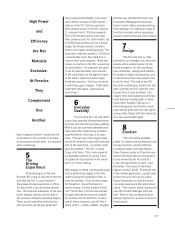Porsche 2015 Annual Report Download - page 99
Download and view the complete annual report
Please find page 99 of the 2015 Porsche annual report below. You can navigate through the pages in the report by either clicking on the pages listed below, or by using the keyword search tool below to find specific information within the annual report.
The new 911 Carrera 4 and 911 Targa 4 models
feature new electro-hydraulically controlled
all-wheel drive and accelerate faster than their
rear-wheel drive counterparts. Fitted with the
optional PDK transmission and Sport Chrono
Package, the 911 Carrera 4 speeds from 0 to
100 km/h in 4.1 seconds, with the S model
coming in at 3.8 seconds. The 911 Carrera S
Cabriolet and 911 Targa 4S, each with PDK
transmission, achieve the new generation’s best
fuel economy in comparison with their prede-
cessors, with average fuel consumption down
1.2 litres to 8.0 l/100 km.
The Macan GTS took centre stage at the Tokyo
Motor Show 2015. With this global launch, the
year’s entire new range of Macan compact
SUVs now includes the Porsche Communication
Management (PCM) that made its debut in
the911 Carrera. Its key features are real-time
traffic information, a simplified interface and
an integrated Wi-Fi hotspot. The Macan GTS
generates 360 hp (265 kW) of power and 500Nm
of torque, placing it between the Macan S and
the Macan Turbo. The SUV accelerates from
0to 100 km/h in 5.2 seconds and features PDK
transmission and Porsche Traction Management
(PTM) that splits the traction variably between
the front and rear axles. Classic GTS design fea-
tures round off the model’s sporty appearance.
Porsche unveiled its new top-of-the-range 911
models – the 911 Turbo and 911 Turbo S – to
aglobal audience at the North American Inter-
national Auto Show in Detroit in January 2016.
In comparison with their predecessors, the high-
performance sports cars boast an additional
20 hp (15 kW) of power, a sharper design and
improved features. The bi-turbo 3.8-litre six-
cylinder engine in the 911 Turbo now produces
540 hp (397 kW) of power. The 911 Turbo S
develops 580 hp (427 kW). Porsche remains the
only manufacturer to use turbochargers with
variable turbine geometry in petrol engines. The
engines now feature a dynamic boost function
to further improve responsiveness. This main-
tains the charge pressure during load changes,
i.e. when the accelerator is released briefly.
Asa result, the engine reacts virtually without
delay when the accelerator is pressed again.
The International Motor Show Germany (IAA) in
Frankfurt in September 2015 set the stage for
the high point of the financial year. The next
generation of the global top-selling 911 Carrera
sports car was unveiled with innovative twin-
turbo Boxer engines, an enhanced chassis and
the new Porsche Communication Management
system. The completely new engine generation –
producing 370 hp (272 kW) in the 911 Carrera
and 420 hp (309 kW) in the 911 Carrera S – each
offer an extra 20 hp (15 kW). Both engines have
adisplacement of three litres. The torque in both
models has increased by a significant 60 Nm in
comparison with their predecessors; the maxi-
mum torque of 450 Nm and 500 Nm respectively
is delivered constantly from a low 1,700 rpm to
5,000 rpm in both cases, making for a superlative
driving experience. At the same time, the maxi-
mum 7,500 rpm clearly exceeds the upper limits
of conventional turbocharged engines. Driving
performance: the Carrera Coupé with PDK trans-
mission and Sport Chrono Package sprints from
0to 100 km/h in 4.2 seconds, with the CarreraS
taking 3.9 seconds. The top speeds are 295 km/h
(911 Carrera) and 308 km/h (911 Carrera S). In
addition, depending on the model variant, the next
generation engines are just under 12 percent
more efficient. For example, the fuel consumption
of the 911 Carrera with PDK transmission is
7.4l/100 km (911 Carrera S: 7.7 l/100 km).
The retuned Porsche Active Suspension Manage-
ment (PASM) chassis sits 10 mm lower and for
the first time is a standard feature for all Carrera
models. It further improves stability during fast
cornering. At the same time, the new shock
absorber generation enhances comfort. The new
Porsche Communication Management (PCM)
system, including an online navigation module
and voice control, can be operated just like a
smartphone with multi-touch gesture control on
the seven-inch screen. User input via handwriting
is also possible. Mobile phones and smartphones
can be connected via Wi-Fi. Another new feature
is the ability to connect an iPhone to the PCM via
Apple CarPlay, and real-time traffic information
isavailable for significantly improved navigation.
2.9 s
is how long it takes the
911 Turbo S Coupé
to accelerate from
zero to 100 km/h.
95


